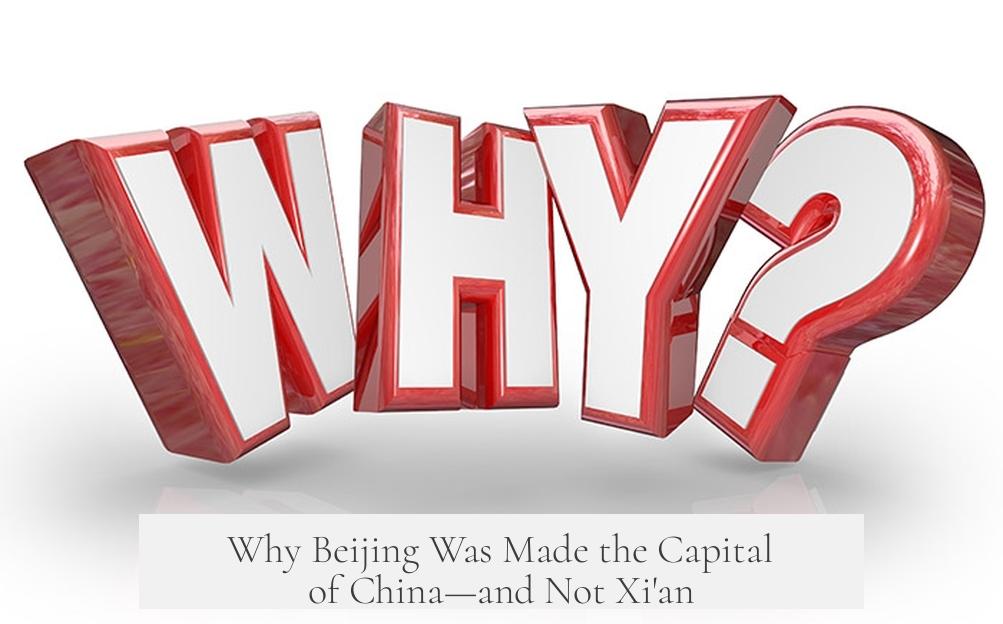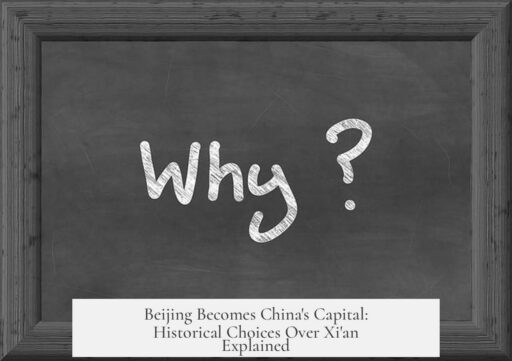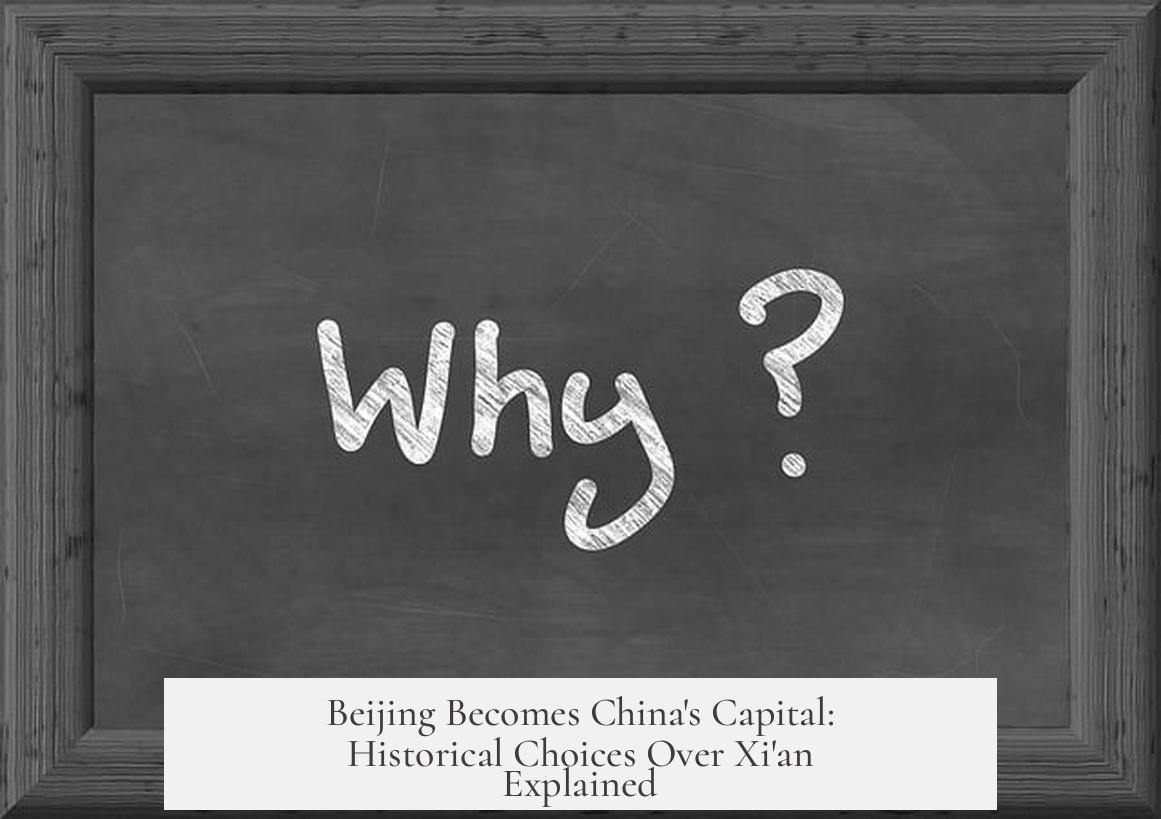Beijing was made the capital of China instead of Xi’an due to a combination of geographic, military, political, and economic factors that evolved over centuries. While Xi’an served as the capital for several early Chinese dynasties, various changes in strategic priorities and external threats led to the relocation to Beijing.
Historically, Xi’an (ancient Chang’an) was the heart of China’s early empires, such as the Qin, Han, Sui, and Tang dynasties. Situated in Shaanxi province, it offered strong natural defenses through surrounding mountains and passes. This protected it from eastern rebellions and internal threats, making Xi’an a suitable political center during these periods. However, the land around Xi’an became overfarmed after many centuries of continuous agriculture. This led to soil exhaustion, making it less viable for sustaining large populations and agricultural production in the long term.
The military situation changed drastically beginning with the Song dynasty. Northern China faced repeated invasions by nomadic groups like the Liao, Jin, Mongols, and later the Manchus. These groups advanced from the north and northwest, changing the defense focus towards controlling strategic mountain passes and plains. The region north of Shaanxi, especially areas near Beijing, gained importance for defense against these incursions. Meanwhile, the Song dynasty struggled to hold these regions, leading to their eventual fall. Control over northern plains was vital because they offered easier transit routes for hostile forces if not properly controlled.
The Yuan dynasty, founded by the Mongols under Kublai Khan, officially shifted the capital to Beijing. After conquering northern China and parts of the south, the Khan moved the seat of government closer to the Mongol homeland and to the center of the newly acquired Han territories. Beijing’s location provided better control over northern China and allowed more effective governance of a vast, multi-ethnic empire. The Mongols also chose Beijing for its proximity to important trade routes and as a power base near their allies in Manchuria and Mongolia.
The Ming dynasty continued Beijing’s role as the capital after Yongle Emperor relocated the imperial government from Nanjing and essentially abandoned Xi’an’s political status. This move addressed ongoing military threats, especially from northern nomads, including Mongols lingering as a force on the border. Building up Beijing enhanced northern defenses, helping prevent further invasions. The Ming also invested heavily in fortifications like the Great Wall extensions near Beijing, highlighting its strategic importance.
The Qing dynasty, established by the Manchus, retained Beijing. Since the Qing came from Manchuria, the capital’s proximity to their homeland provided logistical advantages. Moreover, Qing rulers wanted to legitimize their reign by using the existing Ming political infrastructure in Beijing. The city also facilitated quick military responses to northern frontier issues and access to allied Mongol troops. Thus, maintaining Beijing as the capital symbolized continuity and reinforced Qing authority.
After the Qing, the Chinese Communist Party (CCP) kept Beijing as the capital of the People’s Republic of China. Beijing held immense historical and political significance, representing centuries of imperial rule and central governance. Its geographic position on a plain surrounded by defensible mountains, along with connections to the Grand Canal and nearby port of Tianjin, helped consolidate political and economic control. These factors made Beijing a natural choice despite other cities’ industrial development.
| Factor | Reason Favoring Beijing | Reason Against Xi’an |
|---|---|---|
| Agriculture | – Northern plains and eastern coast areas were agriculturally productive | – Xi’an region suffered from overfarming; soils became infertile |
| Military | – Closer to northern nomadic threats, allowing better defense | – Further from northern threats; had lost strategic importance |
| Political Legitimacy | – Capital continuity post-Yuan and Ming gave Beijing legitimacy | – Old capital, seen as outdated after dynastic changes |
| Geography | – Defensible mountains, access to waterways, proximity to allies | – Surrounded by mountains but isolated from coastal trade |
Other relevant points include the Soviet support in post-War northeast China promoting regional industrialization near Beijing rather than central China’s slower rebuilding areas. Also, the historical failures of past dynasties to keep capitals alive in Xi’an due to shifting threats and political needs showed that geographic and military factors dominate capital placement decisions.
- Xi’an was an early capital but faced agricultural decline and lost strategic value.
- Beijing’s northern location suited defense against invasions from nomadic empires.
- The Mongols and subsequent Ming dynasty officially made Beijing the capital.
- The Qing continued using Beijing to maintain logistics and political legitimacy.
- The CCP preserved Beijing’s status for historical and strategic reasons.
- Economic and military considerations consistently favored Beijing over Xi’an.
Why Beijing Was Made the Capital of China—and Not Xi’an

Simply put, Beijing became the capital instead of Xi’an mainly because of strategic military shifts, agricultural decline in Xi’an, and profound historical events that favored Beijing’s location and political relevance. Now, buckle up for a journey through time, lands, battles, and dynasties that explain why the heart of China beats in Beijing today rather than in Xi’an.
The Decline of Xi’an’s Agricultural Heartbeat
Xi’an, once the proud capital of mighty dynasties like Qin and Han, suffered major blows from overfarming. The fertile lands around Xi’an became infertile, like a tired old field that refuses to grow crops no matter how much you coax it.
Ancient dynasties made heroic attempts to keep Xi’an alive, using creative administrative and cultural maneuvers. Still, it was a losing battle. The agricultural base weakened, forcing new capitals to rise elsewhere. If your kingdom depends on feeding millions, infertile soil isn’t a good start, right?
Military Threats Redrawing China’s Map
The Song Dynasty faced fierce invasions—Liao, Jin, Mongols, and Manchus surged down from the northern Yan Mountains and beyond Datong. Xi’an, tucked farther west, no longer wielded the strategic advantage it once held.
Plus, controlling critical mountain passes became key. The Hebei plains were easier to defend if you held the passes. Unfortunately, the Song couldn’t secure them consistently, resulting in devastating defeats by nomadic hordes. When it comes to staying capital, geography beats nostalgia every time.
Xi’an’s Glorious Past and Its Limitations
Let’s rewind: Qin and Han Dynasties made Xi’an their home base, spreading power eastwards from there. The city sat well-protected by mountains against eastern threats like rebellious princes. It was a fortress in its own right.
Later, the Sui and Tang (Tong) dynasties had royal roots intertwined with northwestern barbarians. Their power structures leaned on those influences. But as dynasties evolved, direct lineage and defense needs shifted, reducing Xi’an’s appeal as the epicenter.
The Ming Dynasty’s Bold Capital Move

Fast forward to the Ming era, the Yongle Emperor had a particular headache—the stubborn Mongols still menacing China’s northern borders. Instead of twiddling thumbs in Xi’an, he uprooted the capital to Beijing, once the Yuan summer capital. By 1421, the grand move was complete.
This was not a random decision! Beijing’s northern position was a frontline fortress against Mongol incursions. The Ming dynasty saw the logic clearly: better to face threats head-on than to wait for them to knock your gates down unexpectedly.
Qing Dynasty Keeps Beijing’s Flame Alive
The Manchurians seized Beijing and decided to keep it as their capital. Why reinvent the wheel? The Ming’s political machinery was already embedded there, saving the Qing dynasty the trouble of rebuilding bureaucratic infrastructure.
Also, Beijing’s proximity to Manchurian homelands and Mongolian allies provided strategic military and political advantages. It wasn’t just luck; it was practical, tactical, and very forward-thinking.
The CCP’s Choice: History and Strategy Combined
Fast forward again, and the Chinese Communist Party also picked Beijing for the new People’s Republic of China’s capital. The city’s rich political history and strategic geographic position sealed the deal.
Beijing sits on a plain that’s shielded by mountains. It’s the launch point of the old Grand Canal linking to Tianjin’s sea port and fertile eastern regions. This made it ideal not just for defense but also for trade and governance.
And Where Does the Mongol Yuan Dynasty Fit In?
Believe it or not, the Mongols were the original movers of the capital to Beijing. Kublai Khan shifted the center from the more remote Xanadu to Beijing after conquering Northern Song territories. The move helped him consolidate conquests and govern Han Chinese lands better.
Beijing’s strategic location was crucial in making the Yuan dynasty’s authority more robust and effective.
Post-War Industrialization and Soviet Assistance

Post-World War II, Beijing’s surrounding areas, especially northeastern China, took advantage of Soviet aid and Japanese industrial development. This made the region more industrialized and practical for rebuilding China’s government apparatus.
Holding the capital in central China would have slowed reconstruction due to lack of infrastructure, while the northeast’s industrial edge supported rapid development. This further justified Beijing’s status as the capital in modern China.
Why Not Xi’an Today?
Xi’an remains a cultural and historical gem, famously known as the home of the Terracotta Army and ancient Silk Road. But from a practical standpoint for a capital city, it faces complex challenges:
- Agricultural decline: The lands are less fertile today compared to the past, limiting local resource support for a capital.
- Geographical vulnerability: Xi’an is less strategically positioned against northern and eastern threats.
- Economic connectivity: It lacks direct access to major seaports and modern industrial hubs essential for governance and commerce.
In contrast, Beijing ticks all the important boxes for military defense, political legitimacy, connectivity, and economic influence.
Final Thoughts: Capitals Are Living Organisms
Choosing a capital city isn’t just about tradition or beauty. It’s about survival, practicality, and vision. While Xi’an was a powerhouse for many centuries, the tides of agricultural viability, military threats, political shifts, and economic needs pulled the capital towards Beijing.
Would China have flourished as it has today had it stubbornly stuck with Xi’an? Maybe. But history shows us survival depends on adaptation more than nostalgia. And Beijing is the master of adapting.
Next time you visit Beijing, remember: you’re walking in the footsteps of emperors, strategists, and visionaries who chose pragmatism over past glories. Capitals are not just places; they are live stories woven by decisions that shape nations.
Why did the Ming Dynasty move the capital from Xi’an to Beijing?
The Ming Dynasty, under the Yongle Emperor, moved the capital to Beijing in 1421. The goal was to better defend against the Mongol threat from the north. Beijing was closer to the northern border and easier to protect.
How did military threats influence the choice of Beijing over Xi’an?
Northern invasions from nomads like the Mongols pressured China. Beijing’s location near strategic mountain passes made it easier to control and defend compared to Xi’an, which faced declining agricultural support.
Why was Xi’an less suitable as a capital in later dynasties?
Xi’an’s land became infertile due to overfarming. Ancient dynasties failed to maintain it as a strong capital. Shifting military threats and agriculture issues made Beijing a better option.
Did the Mongols have any role in Beijing becoming the capital?
Yes, Kublai Khan established Beijing as the capital after conquering northern China. It allowed the Mongols to consolidate their rule closer to Han territories, shifting power from Xi’an.
Why did the Qing Dynasty keep Beijing as the capital?
The Qing kept Beijing because it had Ming governmental infrastructure and was near their Manchurian homeland. It helped them maintain power and secure alliances with northern tribes.




